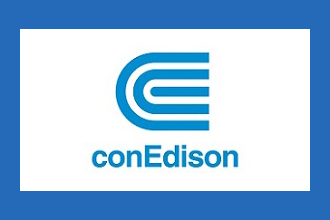Where Does Bronxville’s Electricity Come From?

By Ellen Edwards
Apr. 25, 2018: Con Edison supplies natural gas and electricity to Bronxville, as it also does to New York City, most of Westchester, and to the Metro-North commuter rails in New York and Connecticut.
Con Ed owns and maintains the grid system in our region, which includes 94,000 miles of underground cables and 34,000 miles of overhead wires. The electricity the company acquires—from their own plants or other sources—first travels to transmission substations, which step up the voltage for transmission along many miles of transmission cables. At area substations, the voltage is lowered for local distribution. Transformers then raise the voltage once again before the electricity can enter homes and businesses.
New York State policies encourage diversity in where and how power is generated, with the intention of giving consumers more choice and encouraging the development of “clean” energy. Although Con Ed does produce some of the electricity that flows through its grid, it ultimately buys all its energy in the state marketplace. Bronxville consumers have the choice of getting their energy from Con Ed or through one of hundreds of approved Energy Service Companies (ESCO). Wherever you get your energy, it flows through the grid that Con Ed owns and maintains. Your Con Ed bill separates out what you pay for use of the grid and what you pay for the energy itself.
Through the nonprofit group Sustainable Westchester, twenty towns have decided to purchase energy through Community Choice Aggregation, an exciting, innovative program that sets a fixed price for energy, often saves residents money, and encourages the development of clean energy.
One fourth of Westchester’s power comes from the Indian Point Nuclear Power Plant, owned and operated by Entergy Nuclear, which is slated to close by 2021. The state supports the continued use of nuclear power upstate, where lower population density makes safety and evacuation plans more realistic, and is confident that the loss can be replaced by developing further efficiencies in the electrical system. But many people remain concerned about how we’ll replace such a key source of power.
It takes years for major new sources of power to become available. Residents often fight against having high-voltage power lines in their neighborhoods. Currently, one utility-scale solar installation is in the works, 30 wind farms have been completed or are being built, and the state completed approval of the nation’s largest offshore wind farm, which could power 50,000 homes in Long Island by 2023. Plans to bring hydroelectric power to New York City from Quebec via lines under Lake Champlain and the Hudson River have been in discussion since 2008.
Such challenges are part of what is driving a trend toward more micro-grids—hydro from local streams, solar from rooftops, and small bio-fuel burners. The state is spending $1 billion to make rooftop and community solar installations more accessible and affordable. In 2016, the state produced 1 million megawatt hours from solar power, but solar still accounts for a tiny fraction of the state’s overall energy use.
The grid system is operated by the New York Independent System Operator (NYISO, pronounced NIGH-so), one of 36 nonprofit entities responsible for the Eastern Connection, one of the country’s three main grids. Seven NYISO employees work 24/7 from a multimillion-dollar control room near Albany to determine how much power is needed and which plants are producing it at the lowest cost. If more power is needed, they call on additional plants, including some called “peakers” that may operate only a few days a year during highest demand.
The need for such extra sources of power makes the whole system less efficient. But if the flow of electricity becomes destabilized, equipment can be damaged and power can fail. The weather, which is becoming increasingly extreme and unpredictable, is a major potential disruptor of reliable power, as we experienced this past winter. The congestion of the New York area, which depends on vast amounts of electricity brought into a densely populated region from long distances, also poses a constant challenge.
The electrical grid faces all sorts of threats—from squirrels that gnaw through wires to wind and ice storms that bring down poles, lines, and trees. Con Ed says it has already spent $1 billion since Hurricane Sandy in 2012 to make the system more resilient, yet recent storms suggest there’s still a lot of work to be done.
Village Administrator Jim Palmer said that “the village administration is actively participating in a region-wide review of Con Ed’s response to the recent nor’easters and their filings with the New York State Public Service Commission concerning those events. Our state representatives will be issuing recommendations to the PSC following this review so that the utility can be better prepared for the next event. A further review and evaluation of the cost/benefit of underground electrical service will also be undertaken.”
ConEd is also working to better integrate micro-grids from homeowners and businesses—a challenge for utilities throughout the country. And they’re experimenting with smart meters that provide data on electricity consumption and can diagnose problems remotely.
Meanwhile, a majority of power plants are 40 to 50 years old and will soon need major upgrades. A whopping 80% of transmission lines have been active since before 1980, and NYISO recommends that five thousand miles of transmission lines be replaced over the next three decades, at a cost that they estimate will be $25 billion.
Producing abundant energy requires a complex web of responsibilities among private and public for-profit and nonprofit entities. As the production of energy undergoes the major transformation away from fossil fuels, we will all be called upon to embrace new technologies and ways of living.
Editor's note: Ellen Edwards is a Bronxville resident and a member of the Bronxville Green Committee, which welcomes volunteers.
Editor's note: As a public service, MyhometownBronxville publishes press releases, statements, and articles from local institutions, officeholders, candidates, and individuals. MyhometownBronxville does not fact-check statements therein, and any opinions expressed therein do not necessarily reflect the thinking of its staff.
Government & History Directory
Bronxville is a quaint village (one square mile) located just 16 miles north of midtown Manhattan (roughly 30 minutes on the train) and has a population of approximately 6,500. It is known as a premier community with an excellent public school (K-12) and easy access to Manhattan. Bronxville offers many amenities including an attractive business district, a hospital (Lawrence Hospital), public paddle and tennis courts, fine dining at local restaurants, two private country clubs and a community library.
While the earliest settlers of Bronxville date back to the first half of the 18th century, the history of the modern suburb of Bronxville began in 1890 when William Van Duzer Lawrence purchased a farm and commissioned the architect, William A. Bates, to design a planned community of houses for well-known artists and professionals that became a thriving art colony. This community, now called Lawrence Park, is listed on the National register of Historic Places and many of the homes still have artists’ studios. A neighborhood association within Lawrence Park called “The Hilltop Association” keeps this heritage alive with art shows and other events for neighbors.
Bronxville offers many charming neighborhoods as well as a variety of living options for residents including single family homes, town houses, cooperatives and condominiums. One of the chief benefits of living in “the village” is that your children can attend the Bronxville School.
The Bronxville postal zone (10708, known as “Bronxville PO”) includes the village of Bronxville as well as the Chester Heights section of Eastchester, parts of Tuckahoe and the Lawrence Park West, Cedar Knolls, Armour Villa and Longvale sections of Yonkers. Many of these areas have their own distinct character. For instance, the Armour Villa section has many historic homes and even has its own newsletter called “The Villa Voice” which reports on neighborhood news.
Link to Village of Bronxville One Square Mile Monthly Newsletter
Village of Bronxville Administrative Offices
337-6500
Open 9:00am - 4pm excluding holidays and weekends
Bronxville Police Department
337-0500
Open 24 hours
Bronxville Parking Violations
337-2024
Open 9:00am - 4pm excluding holidays and weekends
Bronxville Fire Deparment
793-6400













